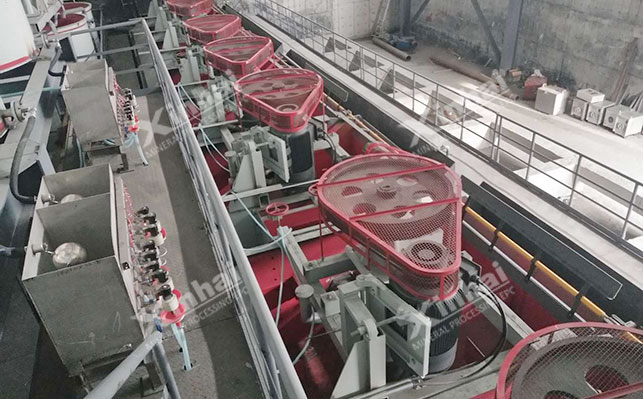Mica is a typical layered silicate mineral, and its main gangue minerals include quartz, feldspar, pyroxene, hornblende, etc. The flotation process uses the difference in physical and chemical properties between mica and gangue minerals to separate them. The key to mica flotation technology lies in the type and dosage of reagents, equipment configuration and control of process parameters.

1.1 Collecting agents: Commonly used collecting agents include fatty acids, amines and alcohols. Selecting the appropriate collector can significantly improve mica recovery. Experiments have shown that fatty acid collectors have a good collection effect on mica under weakly acidic conditions.
1.2 Foaming agent: The role of foaming agent is to produce stable foam, so that mica particles can adhere to the foam and float out. Commonly used foaming agents include pine oil, methyl isobutyl carbinol (MIBC), etc. By adjusting the amount and type of frother, the stability of the foam and the flotation effect can be optimized.
1.3 Adjuster: Adjuster is used to adjust the pH value of the slurry and the charge state of the mineral surface, thus affecting the flotation effect. Commonly used adjusters include lime, sulfuric acid, sodium carbonate, etc. Determining the best type and dosage of adjuster through experiments can improve the recovery rate of mica and the quality of concentrate.
2.1 Flotation machine: Commonly used flotation machines include mechanical agitation flotation machines, air flotation machines and flotation columns.
(1) Mechanical agitation flotation machine: This flotation machine uses a mechanical agitator to fully mix the slurry and reagents, and is suitable for processing fine-grained ores. Its advantages include simple operation and convenient maintenance, the ability to self-absorb air and slurry, easy self-flow when the intermediate ore returns, less auxiliary equipment, and neat equipment configuration.
(2) Air flotation flotation machine: Mineral particles are floated out by introducing bubbles, and are suitable for processing coarse-grained ores. Its advantages are low energy consumption and large processing capacity, but it has high requirements for operating technology.
(3) Flotation column: Flotation is achieved by using columnar structure and bubble distribution, and is suitable for processing complex ores. Its advantages are good flotation effect and low reagent consumption, but the equipment cost is relatively high.
(4) Aerated agitation flotation machine: This flotation machine is equipped with a mechanical agitator and uses an external fan to force air in. Aeration and agitation are separate. Its advantages include that the amount of air can be increased or decreased as needed and can be easily adjusted to remain constant, which is conducive to improving the processing capacity and separation index of the flotation machine; the impeller does not have an air suction function, so the speed is low, the power consumption is low, and the wear is small; due to the large processing capacity and shallow trough, the power consumption per unit processing volume is low.
(5) Inflatable flotation machine: There is no mechanical agitator or transmission parts, and the air for inflation is provided by a specially set air compressor. Its advantages are simple structure and easy manufacturing, but the disadvantages are that there may be no agitator, which may affect the flotation effect to a certain extent, and the aerator is prone to calcium deposition, which is not conducive to air dispersion.

2.2 Grinding equipment: Commonly used grinding equipment includes ball mill, rod mill and autogenous mill. Ball mill is suitable for processing ores with higher hardness, rod mill is suitable for processing ores with lower hardness, and autogenous mill has higher processing capacity and is suitable for processing large-scale ores.
2.3 Classification equipment: Commonly used classification equipment includes spiral classifier and hydrocyclone. Spiral classifier is suitable for processing ore pulp with coarse particle size, while hydrocyclone is suitable for processing ore pulp with fine particle size.
2.4 Dehydration equipment: The dehydration stage is located after flotation. The flotation concentrate is dehydrated to obtain a concentrate with a low moisture content. Commonly used dehydration equipment includes:
(1) High-efficiency concentrator: used for dehydration of concentrate and tailings. It reduces the moisture content in the concentrate through concentration to prepare for subsequent filtration and drying;
(2) Hydrocyclone: It separates the solid particles and water in the mica concentrate through centrifugal force. It is often used for preliminary dehydration;
(3) Dehydration screen: It removes moisture from the mica concentrate through vibration screening. It is suitable for dehydration of fine particles;
(4) Chamber filter press: It squeezes out the moisture in the mica concentrate through pressure to reduce the moisture content;
(5) Vacuum filter: It uses vacuum suction to extract the moisture from the mica concentrate to achieve the dehydration effect.
3.1 Control of slurry concentration: Appropriate slurry concentration can increase the contact opportunity between mineral particles and bubbles, thereby improving the flotation effect. Experiments show that the slurry concentration of mica flotation is generally between 20% and 30%.
3.2 Optimization of flotation time: Too short flotation time will lead to low mica recovery rate, and too long flotation time will increase energy consumption and reagent consumption. Generally speaking, the flotation time of mica is between 5-10 minutes.
3.3 Adjustment of slurry pH value: The pH value of slurry has an important influence on the effect of flotation reagents. By adjusting the pH value of the slurry, the flotation effect can be optimized. Experiments show that the pH value of mica flotation is generally between 6-8.
Flotation is a commonly used method for mica beneficiation. The flotation effect is affected by many factors such as reagents, equipment, and process parameters. In the initial beneficiation test, these factors should be fully considered, and the type and dosage of reagents should be reasonably selected, the beneficiation equipment should be reasonably configured, and the beneficiation process parameters should be reasonably set to obtain a higher concentrate grade and beneficiation recovery rate, thereby obtaining the expected input-output ratio.